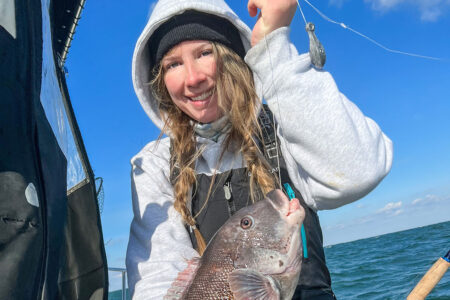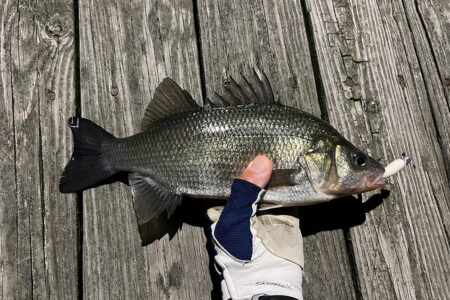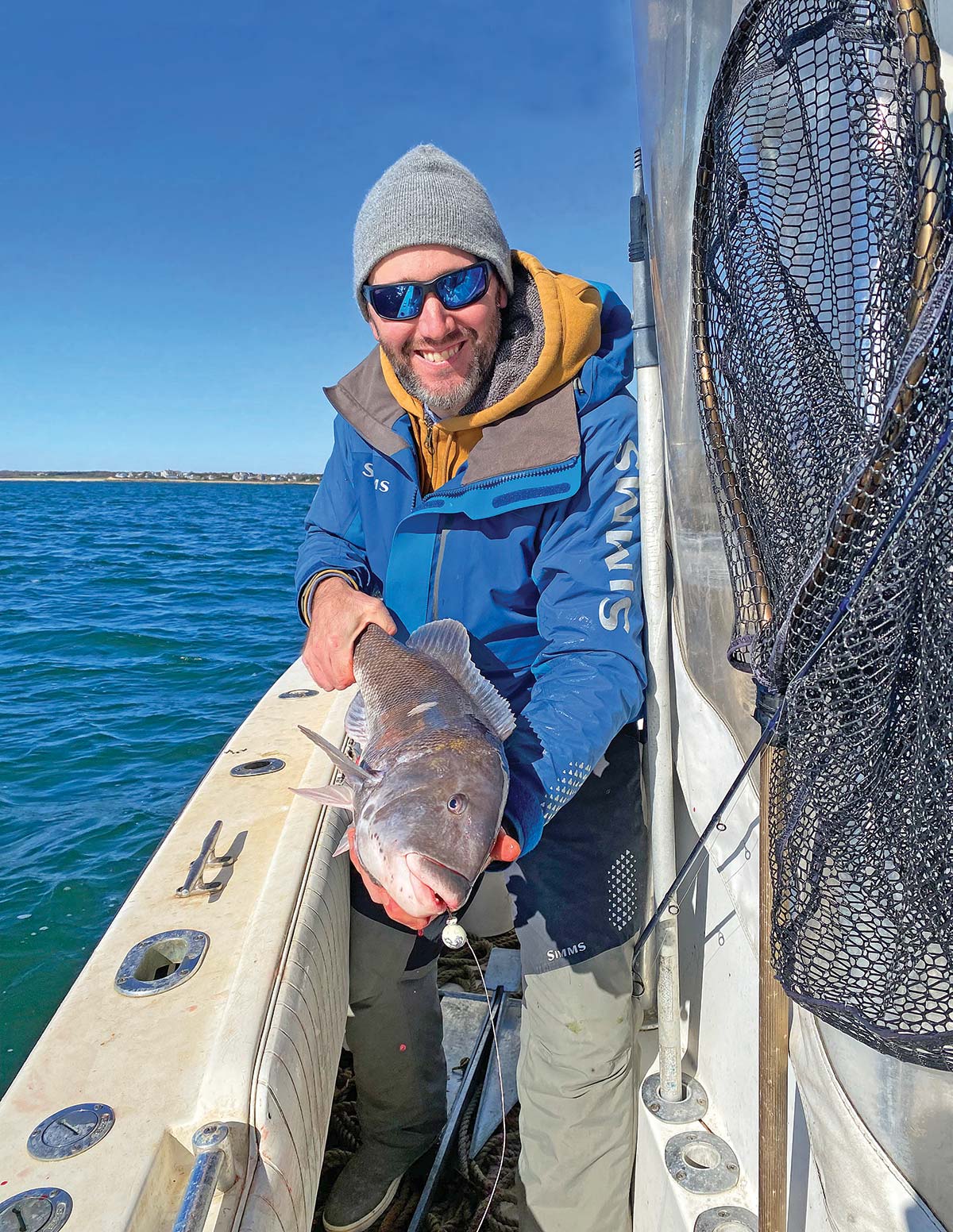
A pro breaks down the art of tog jigging.
“There is a place for everything and everything has it’s place,” someone said that to me long ago and it has stuck with me. On my charter boat, I have been using the same two hook, high/low rig for close to 40 years and it almost always works fine. I also really like swordfish steak but when I go to a restaurant I can’t order the swordfish every time, variety helps add to the appreciation of life and all that it offers to try and experience. So about 15 years ago when Mike Dumias stepped aboard my boat with a 7-foot spinning rod rigged with a tog jig, I “semi-politely” asked him to, “Put that thing back in his car!” He promised me though, that he was going to make me eat my words if I let him try it. So I did, and tog fishing aboard my boat “Little Sister” has never been the same since! That day, not only did Mike out-fish everyone else by a factor of 2 to 1, he also caught the top fish for the trip; in fact Mike and his jig caught all three of the best fish out of the full boat limit.
Don’t Abandon Your Rigs
In the years that followed, I’ve seen more and more of my customers switch over to jigging for tog while others have stuck with the old school approach and they still do just fine; swordfish anyone? But is one way better than the other? Well the only answer is both yes and no. Remember: “there is a place for everything and everything should be in its place”. To apply that to tog fishing, one needs to be ready to utilize the best method for the conditions you have on a particular outing. Also note that those conditions may change during the trip if you make a move, the tide changes of tide or the wind/weather changes. To add another layer, on the new tide you could have a short window where you will find the jig outfit very effective but then the situation gets overpowered by the strength of the tide. So the best advice is to bring two setups!
A consideration to think of when you are choosing what to start with on a given day is “water clarity on the bottom”. If you have had a recent storm (in particular, out of the south or east) and the silt is still settling out, then the visibility on the bottom could be very poor even though the water on the surface looks good. In those conditions I find that the bait rig far out-produces the jig because the jig presentation is below the field of view for a cruising tog while the two hook bait rig usually has at least one bait in view.
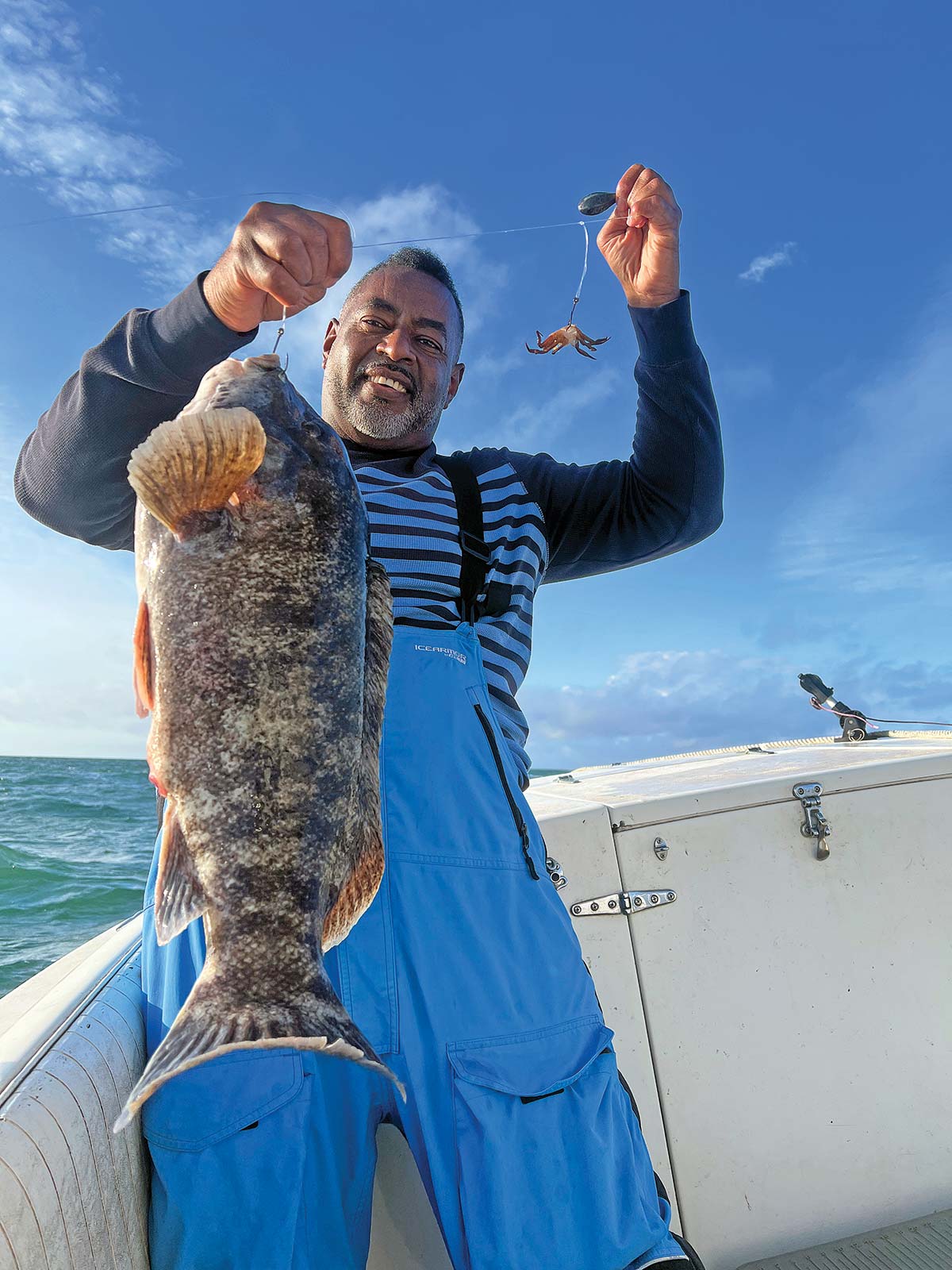
Not Really Jigging
When the uninitiated hear the word ‘jig’ the tendency is to think that you – the angler – will be adding some kind of motion to what you’ll be fishing with. While some tog jiggers will try to move the jig (like a crab walking on the rocks) the truth is, this will usually result in a snag, as your jig slides into a crevice, where it will remain for all of eternity. Can you catch fish while moving the jig? Of course, it’s a piece of their primary food source inside their house but, I see the jig as a delivery system for the crab with the hook. It’s more like a rig that combines the hook and sinker.
The shape of the jighead may help the hook position in relation to the bottom and structure but I do this for a living and I have rarely seen a day when one jig shape was getting hung up more or less than another or catching the most (or the least) fish. One theory that does seem to hold merit is the idea that the color of the jig can help it stand out to the fish. In my experience bright green, orange, white and especially glow colors all work well with the glow being my favorite. One downside to the glow colors is that the paint is less durable and chips much more easily. Many of my customers make a big deal about the shape of the jig and how the hook sits but when the tog are big, they engulf the crab and the jig all at once, now how’s your hook? That is what’s really important, a straightened out hook will ruin your day! My only priority when choosing tog jigs – other than color – is that the hook a strong and sharp.
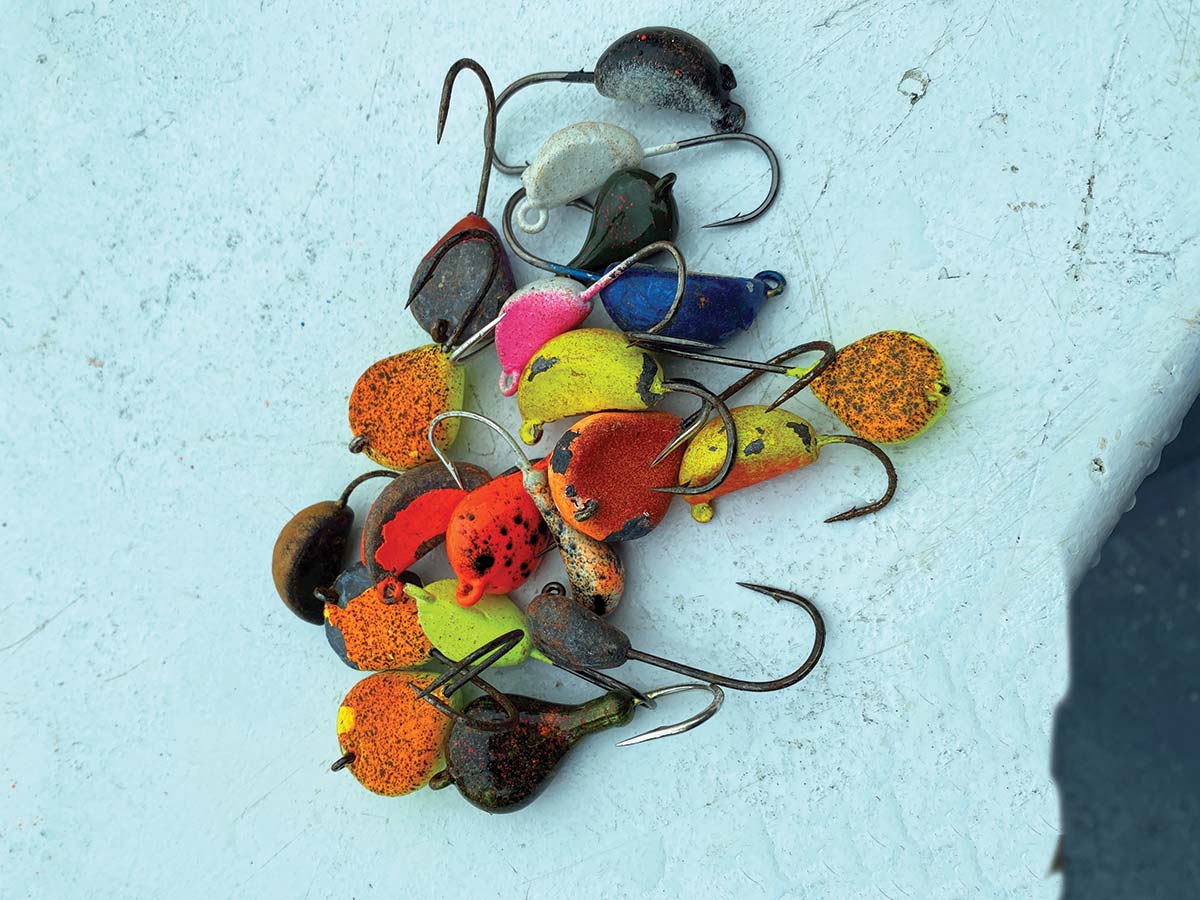
Baiting & Biting
My method for hooking a crab is the same whether I’m using a rig or a jig. First things first, you want your crab to stand out to the tog on the bottom and best way to do that is to expose all the juicy, meaty, oily, stinky stuff inside the shell. I usually just peel the whole shell off the back of a small to medium sized crab. This is easier than it sounds, it’s not much different than splitting open a pistachio nut, just bigger and messier. You also want to discourage little nuisance fish getting in on the action, cutting the legs and claws off really helps, because they have nothing to grab onto. If you’re squeamish about peeling the shell back or if small tog, sea bass and scup are pecking all the meat out of your crabs, simply cracking the shell will slow them down while still leaving the scent in the water. If your crabs are especially large, you can snip off the claws and legs and just cut them in half with a pair of shears—however if you find yourself on a bite of big blackfish sending a whole large crab down is often the best move.
This brings us to the bite. I often (like, almost daily) meet people who have never fished for tautog before and the simplest way to get them to hook up is to say, “There are two kinds of bites; the ‘pecka-pecka’ and the ‘chunka-chunka’. Wait for the ‘chunka-chunka’ and set the hook!” Of course there are as many types of bites as there are types of people but that simple guideline will go a long way for most new toggers while learning when to set the hook. Another mindset that seems to work well for new togging recruits is to ask them to wait until the fish ‘takes the rod down’. Most of the bites you will feel are just the smaller fish chewing on the edges of the crab, the bigger fish don’t really ‘bite the bait’ so much as they just ‘inhale it’ and when that fish moves off with the bait, it takes the rod down.
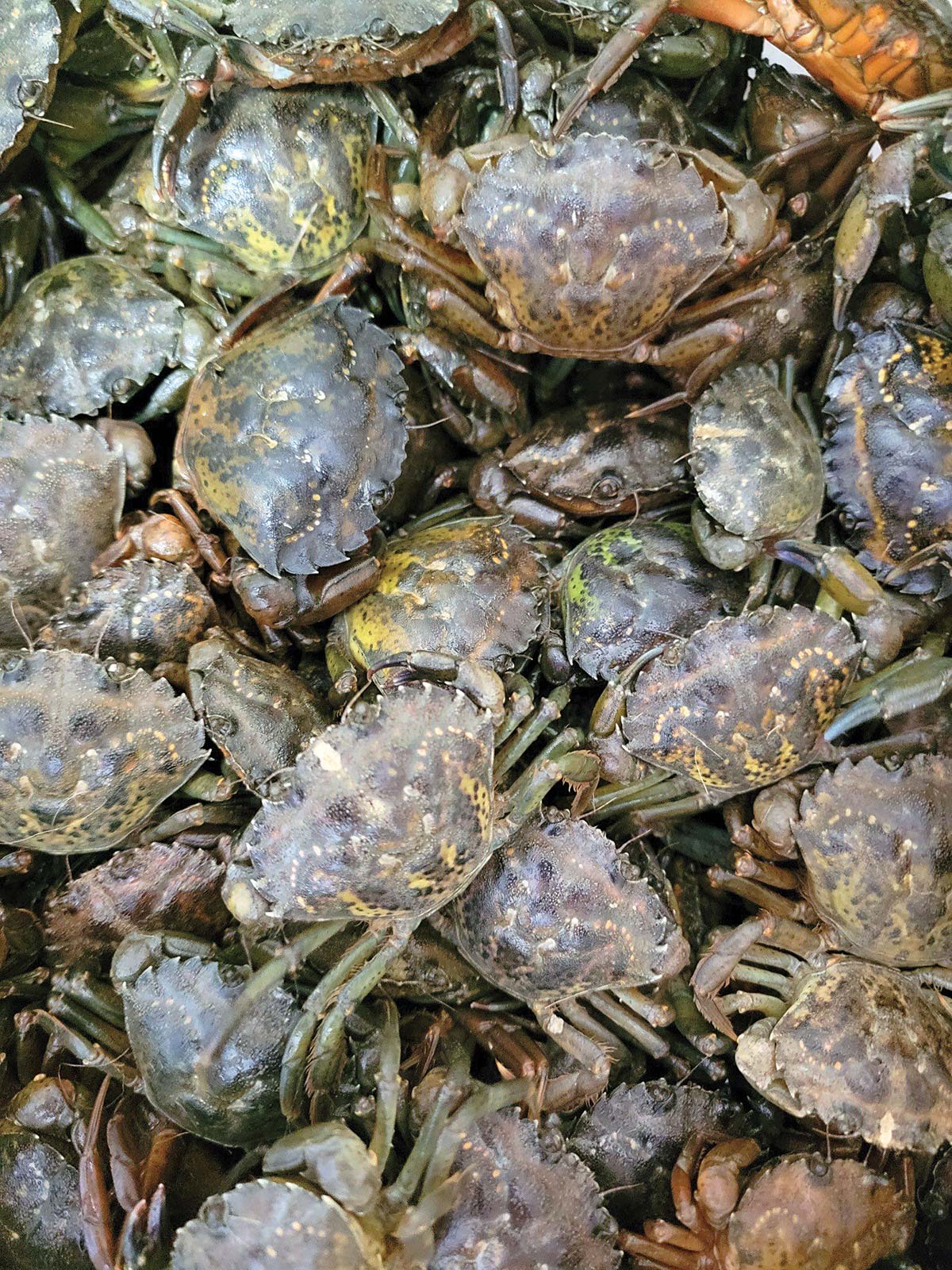
Jigging Sticks
For the jigging rod you can do anything that meets your criteria, and what I mean by that is, you need to consider what is important to you. Do you want to be very sporting and go with 10-pound braid, 20-pound fluoro leader and a 2500 size reel (like a Penn Spinfisher or Slammer)? Or do you want to have your best chance of pulling a monster out of the rocks? For that you can go with a Penn Slammer 4500 spooled with 50-pound braid and finished off with a length of 60-pound fluoro leader. The rod should match the reel, have good quality guides and enough backbone to drive the hook home. When you are fishing a jig in current, be aware that much of your hook set (the sweep of your rod) is wasted on getting the bow/slack out of your line. You may think your line is tight but it never really is unless it’s under a load. Hopefully that load is a big tog, so once you set the hook, it’s wise to crank down and set the hook a second time. Also check your hook points often because a dull hook is another thing can ruin your day!
Now back to that “sporty” stick with the 10-pound braid: I tried that last year with a 2500 Spinfisher and a 6-1/2 foot Tsunami Carbon Shield rod and it was a lot of fun with 1/2- to 3/4-ounce jigs. I landed tog into the double-digits on that setup, but I didn’t stick with it for very long because I found it to be too light. It was tons of fun (and exciting and different), but I broke off a few heartbreakers and that got me annoyed enough that I went back to my heavier rod and 4500 Slammer.
This year I have a compromise for my personal use tog jigging outfit: A Maxell Rod with a 3500 Spinfisher and 20-pound braid. The day after Easter this spring I fished in Florida with author and YouTuber John Skinner for redfish and he used Tsunami Shields for all of his rods down there with 15-pound braid on heavy drag. That got me thinking that your drag can still be pretty tight with light braid as long as you trust your tackle, your connections and your hooks. So, my theory is that I can catch (or lose) just about any tog on light tackle, given the right circumstances, as long as everything works as it should. Well as of this writing it’s late-August and I have already caught some large tog with the new setup and I feel quite comfortable with the upgrade. If you want to create your own personal “I’m serious about catching the world record tog jigging rod” it should be a Penn Slammer 4500 (or similar) paired with a Maxell Platinum MPSPS 761XH rod (or similar) and 40- to 50-pound Power Pro tied to a 4- to 6-foot leader of 60-pound fluoro. I tie the leader to the braid with a uni-to-uni knot which is a bit bulkier than some other connections but I find it to be ultimately reliable. And, I mean, we are looking for the record here right? I’ve seen a lot of broken hearts over the years, most recently (just last fall) when Patrick, George, Dalton and Ron all had unstoppable monsters on that double the tackle would likely not have bested. There are some crazy big fish in those rocks and those rock are not far away!


